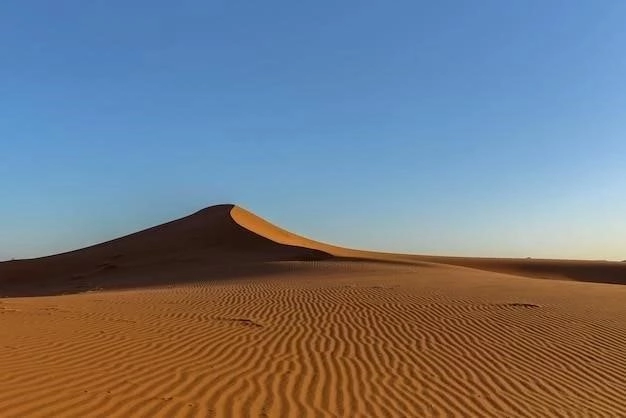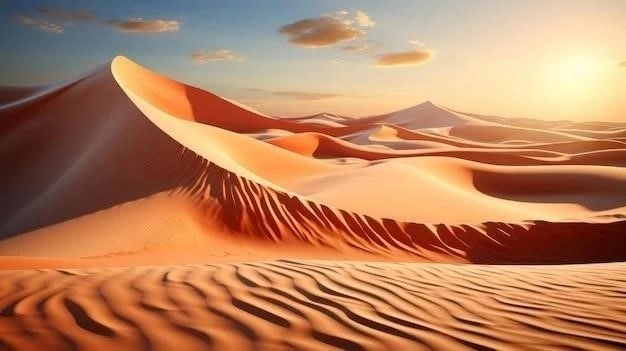The Sahara Desert‚ an expanse of shimmering sand dunes‚ rugged mountains‚ and vast gravel plains‚ is the quintessential image of a desert landscape. Covering much of North Africa‚ it is a place of extremes‚ where scorching temperatures and scarce rainfall create a challenging environment for life to exist. This article delves into the Sahara’s geography‚ climate‚ history‚ and the unique flora and fauna that call this unforgiving yet captivating region home.
Geography and Size
The Sahara Desert is the world’s largest hot desert‚ spanning an area of approximately 9‚200‚000 square kilometers (3‚600‚000 sq mi). It stretches across eleven countries in North Africa‚ including Algeria‚ Chad‚ Egypt‚ Libya‚ Mali‚ Mauritania‚ Morocco‚ Niger‚ Sudan‚ Tunisia‚ and Western Sahara. To put its size into perspective‚ the Sahara is nearly as large as the United States.
Formation and Geological History
The Sahara hasn’t always been a desert. Millions of years ago‚ the region was a lush‚ green landscape with rivers‚ lakes‚ and abundant vegetation. The process that transformed this fertile land into the arid desert we know today is a complex and fascinating one.
Tectonic Shifts and Climate Change
The formation of the Sahara is linked to a combination of tectonic plate movements and long-term climate cycles. Around 7 million years ago‚ the African tectonic plate collided with the Eurasian plate‚ leading to the formation of the Atlas Mountains and the closure of the Tethys Sea‚ which once covered much of North Africa. This closure significantly altered the region’s climate by blocking moist air from reaching the Sahara’s interior.
The Milankovitch Cycles
Over thousands of years‚ subtle changes in Earth’s orbit and tilt‚ known as Milankovitch cycles‚ influence the distribution of solar radiation received on Earth. These cycles played a crucial role in the Sahara’s desertification. Around 5‚000 to 10‚000 years ago‚ a period known as the African Humid Period‚ the Sahara experienced a wetter climate due to a stronger monsoon season. However‚ as the Earth’s tilt shifted‚ the monsoon rains weakened‚ leading to a gradual drying of the Sahara.

Climate and Weather
The Sahara Desert is renowned for its extreme aridity and high temperatures. The climate is characterized by:
Low Precipitation
The Sahara receives less than 250 millimeters (10 inches) of rainfall annually‚ with some areas receiving even less. This lack of precipitation is due to the descending air currents of the Hadley Cell‚ a large-scale atmospheric circulation pattern that creates dry conditions in subtropical regions.
Extreme Temperatures
The Sahara experiences some of the highest temperatures recorded on Earth. Daytime temperatures can soar above 50 degrees Celsius (122 degrees Fahrenheit)‚ while nights can be surprisingly cold‚ especially during the winter months.
Strong Winds
The Sahara is known for its strong winds‚ which can create massive sandstorms that engulf entire regions. These winds‚ often called “harmattan” or “sirocco‚” carry fine sand particles across the desert and even beyond‚ sometimes reaching as far as Europe.

Flora and Fauna
Despite its harsh conditions‚ the Sahara Desert supports a surprising array of plant and animal life that has adapted to survive in this extreme environment.
Vegetation
Sahara vegetation is characterized by its scarcity and adaptation to drought conditions. Common plant species include:
- Xerophytes: Plants like cacti and succulents that store water in their stems or leaves.
- Ephemerals: Plants with short life cycles that germinate‚ grow‚ and reproduce rapidly during brief periods of rainfall.
- Acacia Trees: Drought-resistant trees with deep roots that tap into underground water sources.
Animals
The Sahara’s animal life is equally remarkable for its adaptations. Some of the notable animal inhabitants include:
- Camels: Known as the “ships of the desert‚” camels are perfectly adapted to survive long periods without water and withstand extreme temperatures.
- Fennec Foxes: These small foxes have large ears that help them dissipate heat and hunt for insects in the sand.
- Addax Antelope: These critically endangered antelopes have adapted to survive on minimal water and vegetation.
- Saharan Cheetah: A critically endangered subspecies of cheetah with a lighter coat and adaptations for desert life.

Human Presence and History
The Sahara Desert has been inhabited by humans for millennia‚ with evidence of human presence dating back to the Neolithic period.
Early Inhabitants and Trade Routes
The early inhabitants of the Sahara were nomadic hunter-gatherers who followed the seasonal availability of water and food. As the Sahara dried out‚ these nomadic groups developed sophisticated strategies for survival‚ including the domestication of animals like camels. The Sahara became a crucial trade route connecting North Africa to sub-Saharan Africa‚ with caravans transporting goods such as gold‚ salt‚ and slaves across the vast desert landscape.
Modern-Day Life
Today‚ the Sahara remains sparsely populated‚ with most inhabitants concentrated in oases‚ which are areas with reliable water sources. Life in the Sahara is closely tied to the environment‚ with traditional lifestyles often revolving around pastoralism‚ agriculture (in oases)‚ and trade.
Environmental Concerns
The Sahara Desert faces several environmental challenges‚ including:
Desertification
The process of desertification‚ the expansion of desert-like conditions into semi-arid areas‚ is a significant concern. Climate change‚ overgrazing‚ and unsustainable agricultural practices contribute to this ongoing problem.
Water Scarcity
Water is a precious resource in the Sahara‚ and its scarcity poses challenges for both human populations and ecosystems. Overexploitation of groundwater resources and prolonged droughts exacerbate this issue.

Conclusion
The Sahara Desert‚ a land of stark beauty and unforgiving conditions‚ is a testament to the power of nature’s forces and the resilience of life in the face of adversity. Its vastness‚ its extreme climate‚ and its unique flora and fauna continue to captivate explorers‚ scientists‚ and anyone with a sense of wonder about the natural world. However‚ the Sahara also faces significant environmental challenges that require careful management and conservation efforts to ensure the long-term sustainability of this extraordinary ecosystem and the people who call it home.










